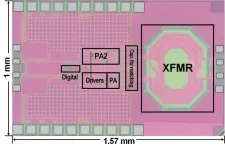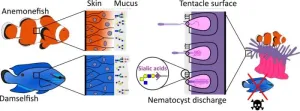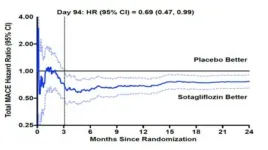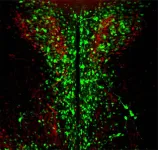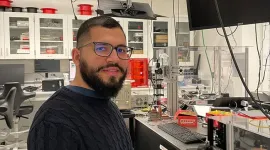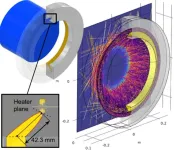Cellular “scaffold” key to first successful implant of myoblasts onto healthy muscle
Big leap for regenerative medicine to treat ageing but intact skeletal muscle
2025-02-15
(Press-News.org)
Tokyo, Japan – Researchers from Tokyo Metropolitan University have developed a way to treat ageing-related muscular atrophy using regenerative medicine. Conventional methods to implant myoblasts, precursors to muscle fiber, required prior scarring for the new cells to graft properly. By adding extracellular matrix (ECM) fluid into the implant, the team successfully grafted myoblasts onto healthy muscle in mice. Their technique opens the way for using implantation to treat unscarred muscle atrophied by ageing.
Age-related muscular atrophy in skeletal muscle can have a devastating impact on people’s quality of life, as well as make them more susceptible to a wide range of diseases. Prevention regimens like resistance exercise and the right diet are vital from a public health perspective but are hardly a complete solution given the scale and immediacy of this societal issue.
That is why researchers have been seeking effective treatments for muscular atrophy. A promising avenue for this work is regenerative medicine, using stem cells to create and augment existing muscle. However, it turns out that this is not so easy. Simply implanting myoblasts, precursors to skeletal muscle, simply does not solve the problem. For the most part, the new cells do not graft into the existing muscle and simply die out. Interestingly, this is not the case when there is an injury present, or a patient has specific diseases like Duchene muscular atrophy, where muscle fibers are collapsing faster than they are being repaired. The common feature is that the muscle is in a “repair mode,” when stem cells in the skeletal muscle tissue called satellite cells are in an activated state, secreting the right signals to enable cell grafting to occur.
Now, a team led by Associate Professor Yasuro Furuichi from Tokyo Metropolitan University has used this insight to develop a new way of implanting myoblasts. Instead of simply injecting myoblasts by themselves, they added some extracellular matrix (ECM) to the injection fluid, the “scaffold” that helps keep cells in place in our bodies. Repair of the ECM is a big part of the process of muscle repair; the team reasoned that the ECM itself may contain some of the right ingredients to trigger the successful grafting of myoblasts into skeletal muscle fiber.
Through experiments on mice, it was found that higher amounts of ECM together with myoblasts lead to higher amounts of myoblasts being grafted into unscarred tissue. This wasn’t without its issues; beyond a certain point, fibrils of collagen began to intrude into the new, healthy tissue (fibrosis). The team was able to solve this by also increasing the concentration of cultured myoblasts in the implant. To date, they have been able to boost the mass of a mouse’s tibialis anterior (in the lower leg) by a massive ten percent.
Though they are yet to find out what ingredient of ECM is helping muscle cells incorporate properly, this is a big step forward for using regenerative medicine to treat a universal public health issue.
This work was supported by a Japan Society for the Promotion of Science (JSPS) KAKENHI Grant-in-Aid for JSPS Fellows (Grant number 24KJ1872), the Japan Science and Technology Agency via the Fusion Oriented Research for Disruptive Science and Technology Program (JST FOREST Program Number JPMJFR205K), a Tokyo Metropolitan Government Advanced Research Grant (R2-2), TMU Strategic Research for Innovative Research Projects, and TMU Young Selection Research Support for Promising Research.
END
[Attachments] See images for this press release:
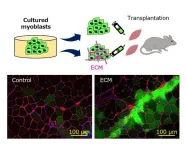
ELSE PRESS RELEASES FROM THIS DATE:
2025-02-15
Three innovative design techniques substantially enhance wireless transmitter performance and can boost power efficiency and elevate data rates concurrently, as reported by the researchers from Science Tokyo, Japan. This effectively aligns with the growing demand for speed and efficiency, accelerating the widespread deployment of wireless devices. This enables synergistic operation of wireless electronic devices and better quality of modern life.
Background:
Integrating artificial intelligence (AI) into everyday life requires the interconnectedness of all electronic devices via a technology called the Internet of Things (IoT). The rapid expansion of the IoT market has ...
2025-02-15
The clownfish-anemone living arrangement is one of the most widely recognized examples of symbiosis. Researchers have made a breakthrough in understanding how anemonefish can live safely among sea anemones without being stung by their venomous tentacles, solving a century-long mystery.
Scientists at the Okinawa Institute of Science and Technology (OIST) and their international collaborators have discovered that anemonefish have evolved to maintain very low levels of sialic acid in their skin mucus to avoid triggering the release of nematocysts (stinging cells) in ...
2025-02-15
Sotagliflozin, a drug recently approved by the Food and Drug Administration to treat type 2 diabetes and kidney disease with additional cardiovascular risk factors, can significantly reduce heart attack and stroke among these patients, according to results from an international clinical trial led by a Mount Sinai researcher.
Sotagliflozin is a sodium-glucose cotransporter (SGLT) inhibitor. It blocks the function of two proteins, known as SGLT1 and SGLT2, which move glucose and sodium across cell membranes and help control blood sugar levels. Other SGLT2 inhibitors do not as significantly block SGLT1.
The study, published ...
2025-02-14
PROVIDENCE, R.I. [Brown University] — Scientists discovered years ago that the hypothalamus — which helps to manage body temperature, hunger, sex drive, sleep and more — includes neurons that express the protein opsin 3 (OPN3). Far less clear, however, was what this light-sensing protein does so deep inside the brain.
A study published in PNAS suggests that OPN3 plays an important role in regulating food consumption.
“Our results uncover a mechanism by which the nonvisual opsin ...
2025-02-14
New blood test could improve Alzheimer’s Disease diagnosis, research finds
Up to half of all people living with Alzheimer’s Disease in Ireland remain undiagnosed. Now, a new blood test may have the potential to transform patient care, allowing for better diagnosis, earlier interventions and more targeted treatments.
Researchers at Trinity College Dublin, the Tallaght Institute of Memory and Cognition and St James’s Hospital, Dublin are exploring the ability of a new blood test, plasma p-tau217, to detect Alzheimer’s Disease (AD). This test could potentially replace the current diagnostic method, a lumbar puncture/spinal tap (which ...
2025-02-14
Cal Poly Assistant Professor Joni Roberts has been chosen, with two additional university faculty members, as the first Cal Poly Faculty Excellence Award honorees.
The inaugural Faculty Excellence Award — an honor recognizing outstanding contributions in teaching, research and service — is administered by the Office of the Provost and funded by generous donor contributions. The award reflects Cal Poly’s commitment to academic excellence and its Learn by Doing philosophy.
The ...
2025-02-14
A new Colorado State University study of the interior U.S. West has found that tree ranges are generally contracting in response to climate change but not expanding into cooler, wetter climates – suggesting that forests are not regenerating fast enough to keep pace with climate change, wildfire, insects and disease.
As the climate becomes too warm for trees in certain places, tree ranges have been expected to shift toward more ideal conditions. The study analyzed national forest inventory data for more than 25,000 plots in ...
2025-02-14
From punch card-operated looms in the 1800s to modern cellphones, if an object has an “on” and an “off” state, it can be used to store information.
In a computer laptop, the binary ones and zeroes are transistors either running at low or high voltage. On a compact disc, the one is a spot where a tiny indented “pit” turns to a flat “land” or vice versa, while a zero is when there’s no change.
Historically, the size of the object making the “ones” and “zeroes” has put a limit on the size of the storage device. But now, University of Chicago Pritzker School of Molecular ...
2025-02-14
RIVERSIDE, Calif. -- In a paper published earlier this month in Physical Review Letters, a team of physicists led by Jonathan Richardson of the University of California, Riverside, showcases how new optical technology can extend the detection range of gravitational-wave observatories such as the Laser Interferometer Gravitational-Wave Observatory, or LIGO, and pave the way for future observatories.
Since 2015, observatories like LIGO have opened a new window on the universe. Plans for future upgrades to the 4-kilometer LIGO detectors and the construction of a next-generation 40-kilometer observatory, Cosmic Explorer, aim to push the gravitational-wave ...
2025-02-14
Dravet syndrome and other developmental epileptic encephalopathies are rare but devastating conditions that cause a host of symptoms in children, including seizures, intellectual disability, and even sudden death.
Most cases are caused by a genetic mutation; Dravet syndrome in particular is most often caused by variants in the sodium channel gene SCN1A.
Recent research from Michigan Medicine takes aim at another variant in SCN1B, which causes an even more severe form of DEE.
Mice without the SCN1B gene experience seizures and 100 percent mortality just ...
LAST 30 PRESS RELEASES:
[Press-News.org] Cellular “scaffold” key to first successful implant of myoblasts onto healthy muscle
Big leap for regenerative medicine to treat ageing but intact skeletal muscle

